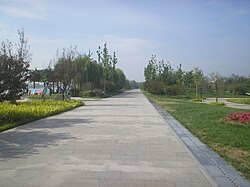Shouguang
This article needs additional citations for verification. (February 2020) |
Shouguang
寿光市 Showkwang, Shou-kuang | ||
|---|---|---|
Postal code 262700 | ||
| Area code | (0)536 | |
| Website | www | |
Shouguang (simplified Chinese: 寿光; traditional Chinese: 壽光; pinyin: Shòuguāng) is a county-level city in the north-central part of Shandong Province, China, situated on the southwest shore of Laizhou Bay. Under the administration of the prefecture-level city of Weifang, it has 1,139,454 people residing within the municipality and its surrounding towns and villages as of the 2010 Census, even though the built-up (or metro) area is much smaller.
It is also known as the 'home of vegetables' in China, owing to its large agricultural output.[1]
History
Shouguang is located on an alluvial plain drained by the Mihe River. This region of Shandong is one of the first places where grains were cultivated.[2] It was also the site of the Neolithic Dawenkou and Beixin cultures. The settlement of Shouguang can be traced back to a Dongyi settlement around 3000 B.C. During the Han dynasty (202 BC–220 AD), Shouguang was established as a county. During that time, it was already one of the largest grain cultivation bases in China, as well as a salt trading center.[1]
The ancient agricultural reference work Qimin Yaoshu was written by Shouguang native Jia Sixie.[1]
During the Ming and Qing Dynasties, vegetables from Shouguang were well regarded, however after the establishment of central planning under Mao Zedong's rule, the city lost its standing as a vegetable producer. In 1984, the city government built a vegetable wholesales market and improved transportation of produce. The market would grow to become China's largest vegetable trading center. In 1989, farmers started utilizing plastic greenhouses and started focusing on higher quality produce. In 2000, Shouguang hosted the World Vegetables Expo. Between 2000 and 2011, the annual growth rate of the local agricultural industry was 11.12%.[1]
Administrative divisions
As 2012, this city is divided to 5 subdistricts and 9 towns.[3]
- Subdistricts
|
|
- Towns
|
|
Climate
| Climate data for Shouguang (1991–2020 normals, extremes 1981–2010) | |||||||||||||
|---|---|---|---|---|---|---|---|---|---|---|---|---|---|
| Month | Jan | Feb | Mar | Apr | May | Jun | Jul | Aug | Sep | Oct | Nov | Dec | Year |
| Record high °C (°F) | 19.2 (66.6) |
25.2 (77.4) |
32.9 (91.2) |
35.6 (96.1) |
38.6 (101.5) |
42.5 (108.5) |
39.8 (103.6) |
37.8 (100.0) |
38.1 (100.6) |
34.8 (94.6) |
26.3 (79.3) |
22.6 (72.7) |
42.5 (108.5) |
| Mean daily maximum °C (°F) | 3.7 (38.7) |
7.5 (45.5) |
14.1 (57.4) |
21.2 (70.2) |
26.8 (80.2) |
31.0 (87.8) |
32.2 (90.0) |
30.7 (87.3) |
27.3 (81.1) |
21.2 (70.2) |
13.0 (55.4) |
5.8 (42.4) |
19.5 (67.2) |
| Daily mean °C (°F) | −1.7 (28.9) |
1.5 (34.7) |
7.6 (45.7) |
14.6 (58.3) |
20.6 (69.1) |
25.0 (77.0) |
27.2 (81.0) |
26.0 (78.8) |
21.6 (70.9) |
15.2 (59.4) |
7.4 (45.3) |
0.5 (32.9) |
13.8 (56.8) |
| Mean daily minimum °C (°F) | −5.8 (21.6) |
−3.0 (26.6) |
2.3 (36.1) |
8.8 (47.8) |
14.8 (58.6) |
19.8 (67.6) |
23.1 (73.6) |
22.2 (72.0) |
17.0 (62.6) |
10.3 (50.5) |
2.8 (37.0) |
−3.6 (25.5) |
9.1 (48.3) |
| Record low °C (°F) | −20.2 (−4.4) |
−15.9 (3.4) |
−9.4 (15.1) |
−3.8 (25.2) |
1.1 (34.0) |
8.4 (47.1) |
15.2 (59.4) |
13.2 (55.8) |
5.9 (42.6) |
−3.4 (25.9) |
−13.7 (7.3) |
−22.2 (−8.0) |
−22.2 (−8.0) |
| Average precipitation mm (inches) | 6.4 (0.25) |
12.6 (0.50) |
11.3 (0.44) |
26.9 (1.06) |
49.0 (1.93) |
75.9 (2.99) |
130.8 (5.15) |
173.9 (6.85) |
46.6 (1.83) |
28.6 (1.13) |
27.5 (1.08) |
9.6 (0.38) |
599.1 (23.59) |
| Average precipitation days (≥ 0.1 mm) | 2.2 | 2.9 | 3.0 | 5.5 | 6.6 | 8.0 | 11.7 | 11.3 | 6.3 | 5.6 | 4.1 | 3.4 | 70.6 |
| Average snowy days | 3.4 | 2.8 | 1.1 | 0.1 | 0 | 0 | 0 | 0 | 0 | 0 | 0.5 | 2.1 | 10 |
| Average relative humidity (%)
|
61 | 57 | 51 | 53 | 57 | 62 | 74 | 79 | 71 | 65 | 64 | 62 | 63 |
| Mean monthly sunshine hours | 165.2 | 170.7 | 218.0 | 235.8 | 265.8 | 231.6 | 192.2 | 187.5 | 195.0 | 193.8 | 164.6 | 165.2 | 2,385.4 |
| Percent possible sunshine | 54 | 55 | 58 | 60 | 60 | 53 | 43 | 45 | 53 | 56 | 54 | 55 | 54 |
| Source: China Meteorological Administration[4][5] | |||||||||||||
Economy
Shouguang is a major hub for vegetables and produce in China, as well as being a major hub for chemical products.[6] Alongside the agricultural industry, related industries such as the packaging and food processing and fertilizer industry have been established. In 2011, Shouguang was the largest glossy and coated paper producer in China. On the coastline fisheries, aquaculture and salt production sites are located.[1]
Sports
The Shouguang Chengtou Stadium is located in Shouguang. The 25,000-capacity stadium is used mostly for association football matches and also sometimes for athletics.[7]
Gallery
|
References
- ^ ISSN 0264-2751.
- .
- ^ 潍坊市-行政区划网 www.xzqh.org (in Chinese). XZQH. Retrieved 2012-05-24.
- ^ 中国气象数据网 – WeatherBk Data (in Simplified Chinese). China Meteorological Administration. Retrieved 12 August 2023.
- ^ 中国气象数据网 (in Simplified Chinese). China Meteorological Administration. Retrieved 12 August 2023.
- ^ Zhong, Raymond (2020-02-04). "$9 Cabbages, Emergency Pork: Coronavirus Tests China on Food". The New York Times.
- ^ "Daum 카페".









